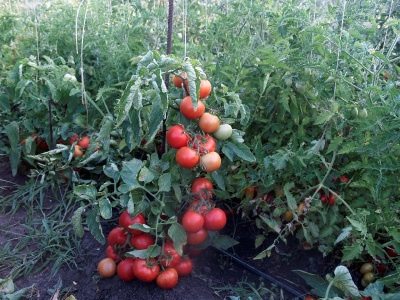
- Authors: L. A. Myazina
- Year of approval: 2007
- Category: hybrid
- Growth type: determinant
- Appointment: fresh consumption, for pickling and preserving, for juice, for ketchup and tomato paste
- Ripening period: ultra early
- Ripening time, days: 80-85
- Growing conditions: for open ground, for film greenhouses
- Marketable fruit yield,%: 90
- Bush height, cm: 50-120
Such a “winter” name should not scare away gardeners - such a tomato has quite “summer” prospects. The main thing is to be able to use it properly, and everything else will follow. But then you will have to study the most objective information about this problem.
Breeding history
The Snowman tomato was developed thanks to the efforts of the breeder L.A. Myazina. The plant was obtained by hybridization. It was officially allowed for cultivation for practical purposes in 2007.
Description of the variety
The snowman demonstrates a full-fledged classic of determinant development. It is planted both in ordinary vegetable gardens and in greenhouses protected by foil. The height of the bushes varies widely, from 0.5 to 1.2 m. The average level of foliage is characteristic. The leaves themselves are of medium size and develop a dark green color.
The main qualities of the fruit
Here the situation is as follows:
the earliest berries are colored in a light green tone;
a ripe crop takes on a bright scarlet color;
the usual weight of tomatoes is 50-120 g;
occasionally there are specimens weighing 150-160 g;
the fruits will develop from a simple inflorescence, and they are fixed on the articulated stalks;
typical flat-rounded flat shape with weakly pronounced ribs;
the berries are divided into 4.5 or 6 nests.
Taste characteristics
The smooth skin does not have any significant effect on the productivity of such a tomato. Its flesh is moderately firm. The official description also emphasizes the pronounced aroma of the fruit. In general, the Snowman berries taste sweetish, but they also have a slight sour note. It is worth emphasizing that the crop is equally suitable for canning in the winter and for preparing summer salads.
Ripening and fruiting
This variety belongs to the ultra-early group. Under favorable conditions, it will take only 80 to 85 days to wait for the berries. However, much depends, traditionally, on the weather and on the measures of care.
Yield
The collection on 1 bush can be 4-5 kg. It is possible to more accurately assess this indicator only taking into account the basic agricultural technology and other nuances. What is important, under good growing conditions, the share of marketable berries reaches 90%.
The timing of planting seedlings and planting in the ground
It is necessary to start sowing seeds in a container from March 10-15. This work should be completed by April 5th. Normally, the seedlings should be ready by April 10-15. But this is achieved only with the earliest planting and careful cultivation of seedlings. With a later sowing, the dates are significantly shifted.

Growing tomato seedlings is an extremely important process, because it largely depends on whether the gardener will be able to harvest at all. All aspects must be taken into account, from seedbed preparation to planting in the ground.
Landing scheme
It is most rational to plant a Snowman tomato according to the 500x600 mm system. Moreover, for 1 sq. m should have from 2.5 to 3.5 bush. It is best to stick to a limited concentration to eliminate errors and help the plants develop fully.

Growing and care
The formation of the bushes should go in 1 or 2 stems. It is strongly recommended to soak planting material for seedlings in a biological stimulator. The final planting is carried out in light soil with organic fertilizers applied in advance. Before each fertilization, the soil is loosened. In general, loosening will be required regularly, and top dressing should be applied 3 or 4 times during the growing season.




A plant needs different micronutrients at each stage of growth. All fertilizers can be divided into two groups: mineral and organic. Folk remedies are often used: iodine, yeast, bird droppings, eggshells.
It is important to observe the rate and period of feeding. This also applies to folk remedies and organic fertilizers.


Growing regions
The variety is zoned for:
Volgo-Vyatka region;
The Far East;
Ural;
West Siberian regions.
Review overview
It is not always possible to give a decent assessment of this culture in the first year of cultivation. Some farmers will "taste" it only in the second season. With luck, a very solid harvest can be reaped. There are also no problems with taste most often. It is also very important to take into account the fact that, according to many reviews, the Snowman has no weak points at all.

























































































